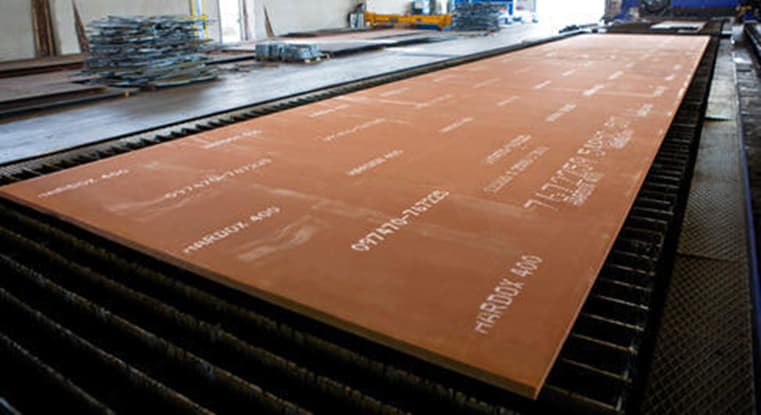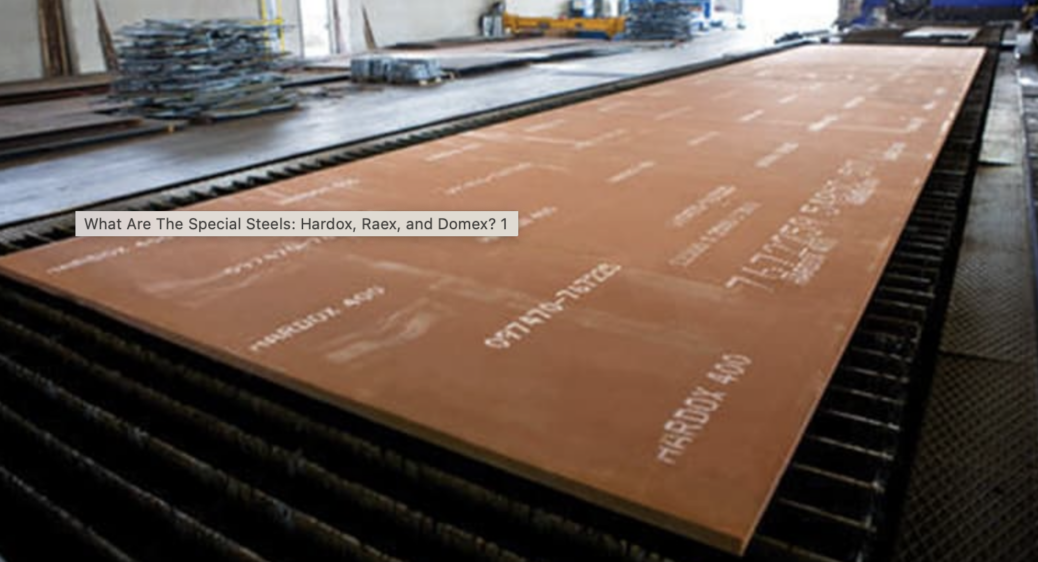Special steels play an important role in manufacturing where strength, wear resistance and bending qualities are required, these metals come to the rescue. Hardox, Domex and Raex are special steels that meet these needs. When strength is required, a thicker structural steel can be considered, indeed the calculations show this; however, the construction will be heavier; For example, it can reduce trailer weight by 30% when replacing standard materials with Domex, which significantly saves fuel consumption, which is an important factor in the automotive industry. Also, if thicker metals are used, another problem is the difficulty in bending, meaning thicker materials are more prone to cracking and the radius must be larger. There are fewer environmental impacts to be considered when using special steels, wear-resistant metals are better for continuous working environments, using a suitable material can greatly extend the life of the parts, thus providing both environmental and economic benefits. Below are machinability, resource properties and where they are used etc. Information will be provided[1].
Hardox Steel
Hardox is a wear resistant steel; Also, the combination of hardness and toughness made this steel the best choice when looking for both properties. Used when in contact with machinery or construction; rocks, sand, coal, minerals, scrap metal, etc. In lower Hardox grades (up to 500), the hardness is combined with a great toughness, which ensures that the metal does not break from impact, and manufacturers agree that the plate hardens completely, which is at least 90% of the core hardness relative to the surface hardness. As a result, it ensures that the wear process is not stabilized after the first layer of material is gone. This property of Hardox makes it suitable to manufacture all structures without cracking and can be bent, shaped or welded without losing other mechanical properties. However, the forming properties are only good when compared to other wear resistant steels but lower than normal steels. At high degrees, the brittleness factor increases with hardness, which means that the use of Hardox as a wear plate is a good option.

Hardox can be produced in different forms; such as a plate, rod, or tube, and all have a serial number at the end; eg Hardox 400 or Hardox 500. The mechanical properties of hardox steels with many subgroups may also vary depending on the classification; For example, Hardox 400 uses include applications with moderate wear, while Hardox 600 is for high wear conditions. Both are suitable for welding, cutting and other processes. These properties are a big plus in the use of steel. Their yield strength also varies between steel grades; For example, the typical yield strength of Hardox 400 is 1100 MPa, but the yield strength of Hardox 600 is about 1650 MPa. Compared to standard structural steels, these values are much higher; For example, S355 has a yield strength around 355 MPa. Hardox 400 is not designed for heat treatment requiring high temperatures, it has achieved its mechanical properties with immediate quenching and post-annealing, its properties cannot be maintained after exposure to temperatures exceeding 250. Care should be exercised and proper health and safety measures should be taken when welding, cutting, grinding or otherwise working on this product; For example, grinding primer coated plates can produce dust with a high particle concentration. Hardox steel wears slowly, reduces maintenance needs and costs, ensures longer life of equipment and aggressive wear environments used in abrasive applications; it also offers a very good combination of hardness, strength and toughness. The high strength of the material allows the use of thinner metal sheets, which means that products can be made simpler and lighter when carrying high bearing loads; moreover, it has good impact resistance even at low temperatures. Hardox plates provide ideal welding and machining properties by simplifying production and repair work and are produced with a highly precise chemical composition to ensure excellent weldability. Advanced hardening and finishing processes also help infuse its good properties, and the combination of high carrying capacity, low maintenance costs, good availability and long service life ensures optimum reliability while saving total cost; In addition, Hardox’s superior wear performance, crack safety and deformation resistance provide defense against wear, dents and cracks[2].
Raex Steel
Raex steel structures are designed to work well in the harshest conditions with extremely abrasive wear and tear; moreover, the wear resistance properties of Raex steels significantly extend the service life of the equipment and reduce costs. Raex reduces weight compared to mild steel and increases the service life of steel structures; In other words, lightweight components generally increase the load carrying capacity by 10-20 percent and make a positive contribution in both economic and environmental factors in vehicles where this steel is used. Raex is a steel that perfectly combines hardness, toughness and machinability, the hardness minimizes wear as the edges of abrasive materials do not cut the plate easily, and the wear resistance remains the same as the material remains equally hard throughout its service life; moreover, Raex is suitable for all structures and surfaces subject to wear and tear; It can also be used as a structural component, thanks to its excellent forming properties and toughness; that is, both a wear-resistant component and a damper body structurally bearing a load can only be made of Raex if desired. Raex steels are ideal for lining equipment parts, such as crushers or bunkers, impact surfaces, conveyor belts, and therefore a grade of steel suitable for use in the mining industry. For example, trucks and machines that transport heavy materials suffer from excessive wear, while thinner Raex plates with higher strength will reduce overall weight and increase payload. Efficiency plays an important role in the recycling process, and when this steel is used as recycling equipment, it is also used in this field as it will allow it to reduce costs, extend its service life and optimize production. Also as another area of use, agricultural machinery and equipment are subject to constant wear and stress, and the machine is extremely vulnerable to wear during tough fieldwork; Therefore, Raex is tough and flexible, extending equipment life and reducing the frequency and cost of replacing wearing parts[3].
Despite their high strength, Raex wear resistant steels can be formed and joined using conventional machining techniques; Also, whether you will weld, bend or machine the material, you can expect reliable performance. Raex steel is easily machined with high speed steel tools, thanks to its properties, drilling, countersinking, tapping, turning and milling using traditional machining techniques. Raex wear-resistant steel provides easy automatic welding with tight thickness tolerances and good flatness, and shortens assembly and assembly time. In addition, these steels are very suitable for free and roller bending due to their uniform properties such as narrow thickness tolerances and smooth surface and cutting properties of Raex wear resistant steels; It can be cut both hot and cold and recommended methods are oxyfuel, plasma or laser cutting.
Domex Steel
These steels are a form of hot rolled steel, a low alloyed and cold formed high strength steel and their intended use is in the engineering and automotive industries. This area of use means that steel is great for applications such as CNC machining. There are some differences that distinguish Domex steels from other steel groups; for example, they perfectly adapt to cold forming, promise tighter tolerances, a wider selection of suitable welding processes and consistent quality, and basically this is everyday steel grade that provides a little extra in every respect; However, the most striking of these qualities are their near-perfect qualities for bending. Domex classes are also numbered, and each class also has a suffix. MC, ML, LA and LAD. MC refers to thermomechanically rolled steels suitable for cold forming; ML thermomechanically rolled steels suitable for low temperatures; LA steels are low alloy cold rolled steels, LAD steels are metal coated for corrosion protection. This type of steel has low levels of both carbon and manganese and has precisely added grain refiners such as vanadium, titanium and niobium, and the result and overall clean structure is one of the most competitive alternatives available for both cold formed and welded products[4]. A wide variety of Domex steel grades are available, including normal cold forming grades, wear resistant grades, corrosion resistant grades, ballistic protection and electric plate. In addition to high strength, Domex steels also have good weldability and very good formability, which means they can withstand a large number of production processes including pressing, fabrication and machining. Domex is superior to mild steel as it offers better strength and higher quality; Therefore, studies tend to require less steel and have a lower structural weight, contributing to lower costs for manufacturing. Statistically, this result has been found to reach 30%, so it is an excellent material for the automotive industry; Moreover, automakers aim to maintain a low structural weight while maintaining high grip. This material is great for fixing these types of targets.
References
[1] Bringas, John E. (2004). Handbook of Comparative World Steel Standards: Third Edition (PDF) (3rd. ed.). ASTM International. p. 14. ISBN 0-8031-3362-6. Archived from the original (PDF) on 2007-01-27.
[2] “Steel Industry”. Archived from the original on 2009-06-18. Retrieved 2009-07-12.
[3] Retrieved from: https://www.ruukki.com
[4] Retrieved from: https://www.ssab.com/company/about-ssab


